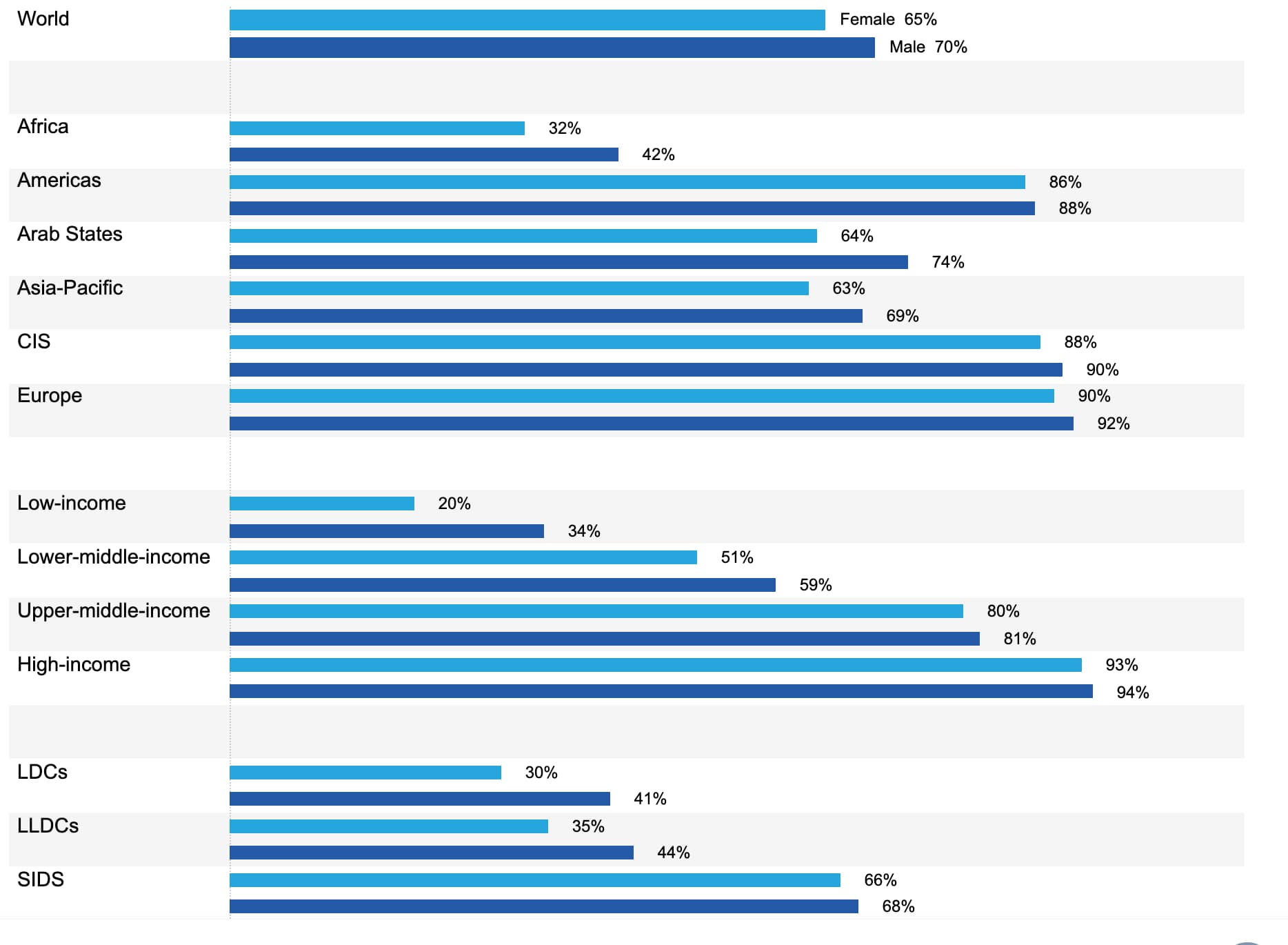2025 Broadband Advocacy Targets / Target 7
2025 Broadband Advocacy Target 7
BRIDGE THE GENDER DIGITAL DIVIDE
By 2025, gender equality should be achieved across all targets
The Broadband Commission introduced the seventh advocacy target in 2013, drawing attention to the importance of gender equality among Internet users, so that the benefits of broadband Internet reach all. This is also aligned with the United Nations’ Sustainable Development Goal 5: to achieve gender equality and empower all women and girls.

Explore our comprehensive compilation of policy recommendations for advancing SDG5: Gender Equality, focusing on the Broadband Commission’s mission to bridge the digital gender divide
Tracking progress
According to the latest ITU estimates, 70 per cent of all men were using the Internet in 2023 compared to 65 per cent of women. Gender parity increased from 0.90 in 2019 to 0.92 in 2023. Some regions and income groups have achieved gender parity in Internet usage, including some among high-income countries, SIDS, Latin America and the Caribbeans, CIS countries, and Europe.
However, despite increases in gender parity, women account for a disproportionate – and increasing – share of the global offline population. In fact, women now outnumber male non-Internet users by 17 per cent, up from 11 per cent in 2019.
Least developed countries continue to exhibit low levels of Internet use and to generate low gender parity scores despite having made noticeable progress in recent years in both usage and gender parity. Landlocked developing countries have shown only limited progress towards gender parity since 2019.
As reported by GSMA, women were 19 per cent less likely than men to use mobile Internet across LMICs in 2023. By comparison, this gender gap was 15 per cent in 2020, and prior to that it had reduced every year from 25 per cent in 2017. While more women continue to use the mobile Internet than ever before, and it remains the primary way most people access the Internet in LMICs, their rate of adoption has slowed over the last year, and historically noted that rural women in developing countries are particularly disadvantaged. Furthermore, in some countries, men’s rates of mobile Internet adoption have been higher than that of women’s, driving an increase in the mobile Internet gender gap.
In addition, the UNESCO 2023 GEM Report found that according to UIS data, women in STEM accounted for just one third of global tertiary graduates in 2016–18. Gender is one of the strongest determinants of the likelihood of pursuing education and careers in STEM. Boys in grade eight were more willing to pursue a mathematics-related occupation than their female schoolmates in 87% of the education systems participating in the 2019 Trends in International Mathematics and Science Study (TIMSS).
Percentage of female and male population using the Internet, 2023

Source: ITU Facts and Figures 2023
Transformative risks and opportunities
Internet use parallels smartphone ownership gaps – with similar socio-economic challenges resulting from lack of access to information
Similar to the story seen in mobile Internet use, the gender gap in smartphone ownership had been reducing year-on-year across LMICs – from 20 per cent in 2017 to 16 per cent in 2020—but over the last year this has reversed. Women are currently 17 per cent less likely than men to own a smartphone. These gender gaps also exist in women’s access to and use of mobile money services as well as digital literacy, which are helping drive financial inclusion for women, can increase their economic independence, and strengthen their role as financial decision-makers. Additionally, mobile ownership would facilitate women’s access to information, foster their digital and media and information literacy ensuring that they are equipped for the challenges of the new digital era. Improved digital skills would also enable them to contribute to shaping the digital environment, as bolstering their digital defences against discrimination and other violence against them, such as gender-based violence online.
Opportunity to improve the affordability of smartphones and data to drive digital inclusion of women
Affordability, particularly of handsets, is the primary barrier to mobile ownership, and a challenge for both men and women to start using mobile data and services. Women usually experience the affordability barrier more acutely than men, due to lower average incomes, lower access to external sources of finance and less financial independence. To make handsets and data more affordable, governments can ensure policies and regulations help lower the cost of handsets and data for consumers, which is likely to disproportionately benefit women. For example, governments can review and remove sector-specific taxes and fees for handsets and data including import taxes that treat handsets as luxury items. Governments can also consider subsidy programmes in consultation with the private sector to help improve the affordability of handsets and data. This could include subsidies that increase smartphone ownership among women or subsidising data for underserved women.
Gender gaps must be bridged on all economic landscapes and at all levels of the ICT value chain
Significant gender gaps remain at other levels of the ICT value chain. The UNESCO Report on “The Effects of AI on the Working Lives of Women” found that women represent only 29% of science R&D positions globally. Among the world’s leading tech companies, just 23 per cent of women were engaged in roles such as software development and engineering, and women represented only 26 per cent of board members in 2020.

